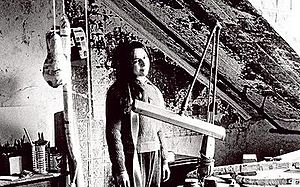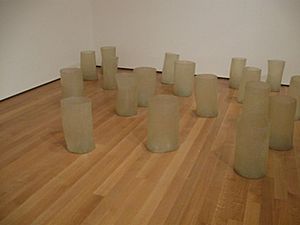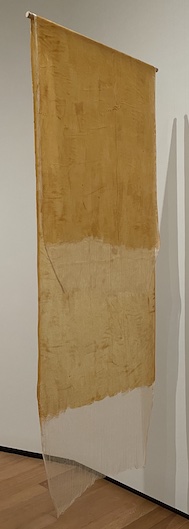Eva Hesse facts for kids
Quick facts for kids
Eva Hesse
|
|
|---|---|

Hesse in her studio in 1965
|
|
| Born | January 11, 1936 |
| Died | May 29, 1970 (aged 34) New York City, U.S.
|
| Nationality | American |
| Education | Yale University, studied with Josef Albers at Yale, Cooper Union, Pratt Institute, Art Students League of New York |
| Known for | Sculpture |
| Movement | Postminimalism |
| Spouse(s) | Tom Doyle (1961–66; divorced) |
Eva Hesse (born January 11, 1936 – died May 29, 1970) was an American sculptor. She was born in Germany. She became famous for using new materials like latex, fiberglass, and plastics in her art. Eva Hesse was one of the artists who started the postminimal art movement in the 1960s.
Contents
Her Life Story
Eva Hesse was born in Hamburg, Germany, on January 11, 1936. Her family was Jewish. When she was two years old, in December 1938, her parents sent her and her older sister, Helen, to the Netherlands. They were trying to escape from Nazi Germany. They traveled on one of the last Kindertransport trains, which saved many Jewish children.
After about six months, the family was together again. They moved to England and then, in 1939, to New York City. They settled in Manhattan's Washington Heights. In 1944, Eva's parents separated. Her father remarried in 1945, and her mother died in 1946. In 1961, Eva met and married sculptor Tom Doyle. They divorced in 1966.
In October 1969, doctors found a brain tumor. Eva Hesse died on May 29, 1970, after three operations. She was only 34 years old. Her death ended a career that lasted only ten years but became very important.
Her Art Career
Eva Hesse finished high school at New York's School of Industrial Art when she was 16. In 1952, she started studying at the Pratt Institute of Design but left after a year. When she was 18, she worked as an intern at Seventeen magazine. She also took classes at the Art Students League. From 1954 to 1957, she studied at Cooper Union. In 1959, she earned her degree from Yale University. At Yale, she studied with Josef Albers and was greatly influenced by Abstract Expressionism.
After Yale, Eva Hesse returned to New York. She became friends with many other young minimalist artists. These included Sol LeWitt, Donald Judd, and Yayoi Kusama. Her close friendship with Sol LeWitt lasted until she died. They often wrote letters to each other. In 1965, LeWitt famously told her to "Stop [thinking] and just DO!" Both Hesse and LeWitt became very important artists. Their friendship helped their art grow.
In November 1961, Eva Hesse married fellow sculptor Tom Doyle. In August 1962, they took part in an Allan Kaprow Happening in Woodstock, New York. A "Happening" is a type of performance art. There, Eva made her first three-dimensional artwork, which was a costume for the event. In 1963, Eva Hesse had her own show of drawings at the Allan Stone Gallery in New York.
By 1965, Eva and Tom moved to Germany. Tom had an artist's residency there. Eva was not happy about the move. Their marriage was also falling apart. They lived and worked in an old textile mill near Essen for about a year. The building still had machine parts and tools from when it was used. These old machines inspired Eva's drawings and paintings. Her first sculpture was a relief called Ringaround Arosie. It was made with cloth-covered cord, electrical wire, and masonite. This year in Germany was a big turning point for Eva. From then on, she focused mainly on making sculptures. When she returned to New York City in 1965, she started working with unusual materials. These materials, like latex, fiberglass, and plastic, became a key part of her art.
How She Made Art and What She Used

Eva Hesse's early works (1960–65) were mostly abstract drawings and paintings. She is more famous for her sculptures. Because of this, her drawings are sometimes seen as just ideas for her later sculptures. However, she made most of her drawings as a separate group of works. She said, "they were related because they were mine but they weren’t related in one completing the other."

Eva Hesse liked using latex for her sculptures because it was immediate. This means she could work with it quickly. Art critic John Keats said, "immediacy may be one of the prime reasons Hesse was attracted to latex." In her first two latex works, Schema and Sequel (1967–68), she used latex in a new way. For her artwork Untitled (Rope Piece), she used industrial latex. Once it hardened, she hung it on the wall and ceiling with wire. She used latex like house paint, brushing many layers to create a surface that was smooth but also uneven.
Hesse's art often uses many similar shapes grouped together. They might be in grid patterns or in clusters. She kept some ideas from minimalism, like using repeated parts and unusual materials. But she made unique art that was often repetitive and took a lot of effort. Her work Contingent from 1968 is a good example of this. Eva Hesse described her piece Hang-Up as "...the first time my idea of absurdity or extreme feeling came through... It is extreme and that is why I like it and don't like it... It is the most ridiculous structure that I ever made and that is why it is really good."
Postminimalism and Feminism

Eva Hesse is linked to the Postminimal art movement. This movement came after minimalism.
Hesse worked alongside and sometimes competed with male artists in post-minimalist art. This art movement was mostly led by men. Many art historians who study women's art have said that her work shows women’s issues. However, it does not have a clear political message. In a letter to Ethelyn Honig in 1965, she wrote that a woman is "at disadvantage from the beginning… She lacks conviction that she has the ‘right’ to achievement." She also said that "a fantastic strength is necessary and courage." Hesse said her art was feminine but not strictly feminist. In an interview in 1970, she stated, "The way to beat discrimination in art is by art. Excellence has no sex."
Keeping Her Art Safe
There has been a lot of talk about how to best keep Eva Hesse’s sculptures safe. Most of the materials she liked to use, except fiberglass, have not aged well. This makes it very hard for art conservators to preserve her work. Arthur Danto, an art critic, wrote about a 2006 show of her art. He mentioned "the discolorations, the slackness in the membrane-like latex, the palpable aging of the material…" But he also said, "Yet, somehow the work does not feel tragic. Instead, it is full of life, of eros, even of comedy…"
Sometimes, her art is too damaged to be shown. For example, Sans III cannot be shown anymore because the latex boxes have curled up and crumbled. Eva Hesse’s close friend Sol LeWitt believed her work should be actively preserved. He said, "She wanted her work to last..." Many of her other friends agreed with LeWitt. However, Eva Hesse also had mixed feelings about her art lasting forever. She once wrote, "At this point, I feel a little guilty when people want to buy it. I think they know but I want to write them a letter and say it's not going to last. I am not sure what my stand on lasting really is. Part of me feels that it’s superfluous and if I need to use rubber that is more important. Life doesn’t last; art doesn't last."
Her Legacy
People often look at Eva Hesse's art in connection with the many hard times in her life. These include escaping the Nazis, her parents' divorce, her mother's death when she was 10, her failed marriage, and her father's death. A 2016 documentary called Eva Hesse showed her difficult past. The film tells the story of her "tragically foreshortened life." It "focuses on those years of artistic emergence, a period of rapid development and furious productivity."
While her experiences certainly affected her, the real impact of her art comes from her artistic inventions. For example, she used materials in new ways. She also responded to the minimalist movement in a modern way. She helped start the postmodern and postminimalist art movements.
Eva Hesse was one of the first artists in the 1960s to explore the natural, flowing shapes found in nature. She also used very simple artistic ideas. Some people see her art as having early feminist ideas related to the female body. Others find humor and playfulness in her soft shapes. She often used everyday materials she found around her. Important artists like Japanese artist Eiji Sumi have said she influenced them.
Art Shows and Exhibitions
In 1961, Eva Hesse's paintings were shown in the Brooklyn Museum’s 21st International Watercolor Biennial. At the same time, her drawings were in a show called Drawings: Three Young Americans at the John Heller Gallery. In August 1962, she and Tom Doyle took part in an Allan Kaprow Happening in Woodstock, New York. In 1963, Hesse had a solo show of her drawings at the Allan Stone Gallery in New York. Her first solo show of sculptures was in Düsseldorf, Germany, in 1965.
In November 1968, she showed her large sculptures at the Fischbach Gallery in New York. This show was called Chain Polymers. It was her only solo sculpture exhibition in the United States during her lifetime. This exhibition was very important for her career and made her famous. Her large piece Expanded Expansion was shown at the Whitney Museum in 1969.
After her death, there have been many major exhibitions of her work in the United States and Europe. One early show was at the Guggenheim Museum in 1972. In 1979, three separate shows called Eva Hesse: Sculpture were held. These took place in London, Otterlo, and Hannover. One artwork in these shows was Aught, which had four double sheets of latex filled with polyethylene. In 1982, Ellen H. Johnson organized the first show just for Hesse's drawings. This show traveled to several museums. In 1992 and 1993, more shows were held in New Haven, Valencia, and Paris.
Many big exhibitions have been organized since the early 2000s. These include a major show in 2002 that traveled to the San Francisco Museum of Modern Art, Tate Modern, and Museum Wiesbaden. In 2006, there were shows at The Drawing Center and the Jewish Museum of New York. In Europe, Hesse had recent shows in Barcelona (2010) and Edinburgh (2009). An exhibition of her drawings from the Allen Memorial Art Museum will travel in 2019-2020.
Where Her Art is Kept
More than 20 of Eva Hesse's artworks are in the Museum of Modern Art in New York. The largest collection of her work outside the United States is at the Museum Wiesbaden in Germany. This museum started buying her work after a 1990 exhibition. One of the biggest collections of Hesse's drawings is at the Allen Memorial Art Museum at Oberlin College. This museum also has the Eva Hesse Archive, which her sister donated in 1977. Other public collections that own her work include the Art Institute of Chicago, the Hirshhorn Museum and Sculpture Garden, the National Gallery of Australia, the Nelson-Atkins Museum of Art, the San Francisco Museum of Modern Art, the Solomon R. Guggenheim Museum, the Tate Gallery, the Jewish Museum, and the Whitney Museum of American Art.
Some of Her Famous Artworks
- Untitled. 1963–64. Oil on canvas. The Jewish Museum (Manhattan).
- Ringaround Arosie. 1965. Mixed media. Museum of Modern Art, New York.
- Laocoön. 1965-66. Mixed media. Allen Memorial Art Museum, Oberlin.
- Untitled or Not Yet. Nets. 1966. Polyethylene, paper, lead weights, and cord. San Francisco Museum of Modern Art, San Francisco.
- Hang Up. 1966. Acrylic on cloth over wood; acrylic on cord over steel tube. Art Institute of Chicago, Chicago.
- Addendum. 1967. Painted papier-mâché, wood and cord. Tate Collection.
- Repetition Nineteen III. 1968. Fiberglass and polyester resin. Museum of Modern Art, New York.
- Sans II. 1968. Fiberglass and polyester resin. Divided among several museums.
- Contingent. 1969. Cheesecloth, latex, fiberglass. National Gallery of Australia, Canberra.
- Accession II. 1969. Galvanized steel and vinyl. Detroit Institute of Arts, Detroit.
- Right After. 1969. Fiberglass. Milwaukee Art Museum, Milwaukee.
- Expanded Expansion. 1969. Fiberglass, polyester resin, latex, and cheesecloth. Guggenheim Museum, New York.
- No Title. 1969–70. Latex, rope, string, and wire. Whitney Museum of American Art.
Images for kids
-
Repetition 19, III (1968), made of fiberglass and polyester resin, at the Museum of Modern Art
-
One More Than One (1967) at the National Gallery of Art in 2022
-
Test Piece for "Contingent" (1969) at the National Gallery of Art in 2022
See also
 In Spanish: Eva Hesse para niños
In Spanish: Eva Hesse para niños



